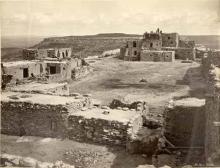Article
On the Hopi Reservation in north-central Arizona, which is completely surrounded by the Navajo Reservation, there are twelve Hopi villages. These villages are not in the exact same places as they were in the 1500s, but the people there still live in tune with the traditional ways. The Hopi are a Pueblo people, named as such by the Spanish colonizers because of their traditional building style, which reminded the Spaniards of their own small towns, or pueblos, on the Iberian Peninsula. The cluster of Hopi villages are located on three peninsular mesas, First Mesa, Second Mesa, and Third Mesa, that form the southern edge of Black Mesa. Although the customs, language, and rituals of the tribe across the villages and mesa are intertwined and similar, the villages do have their own unique variations and specific customs. First Mesa includes the villages of Walpi, Sichomovi, and Tewa (Hano). Walpi is the oldest village and has had inhabitants since 900 AD. Second Mesa is the home of the villages of Shungopavi, Mishongovi, and Sipaulovi. Third Mesa includes Kykotsmovi (New Oraibi), Old Oraibi, Hotevilla, and Bacavi.
"Hano Pueblo, Hopi, Arizona, circa 1870," photograph by John K. Hillers. (046101). Palace of the Governors Photo Archive, New Mexico History Museum.
Manuscripts
References
The Hopi Tribe
2015 The Hopi Tribe Official Website. http://www.hopi-nsn.gov/, accessed February 20,
2015.
Linford, Laurance D.
2001 Tony Hillerman's Navajoland: Hideouts, Haunts, and Havens in the Joe Leaphorn
and Jim Chee Mysteries. Salt Lake City: University of Utah Press.
Ruiter, Brian De
2014 Hopi. Encyclopedia of Native American History, Volume 1. New York: Facts On File.
American Indian History Online.
http://online.infobase.com/HRC/Search/Details/358922?q=hopi, accessed February 20,
2015.
Waldman, Carl
2006 Hopi. Encyclopedia of Native American Tribes, Third Edition. New York: Facts On
File. American Indian History Online.
http://online.infobase.com/HRC/Search/Details/191105?q=hopi, accessed February 20,
2015.

